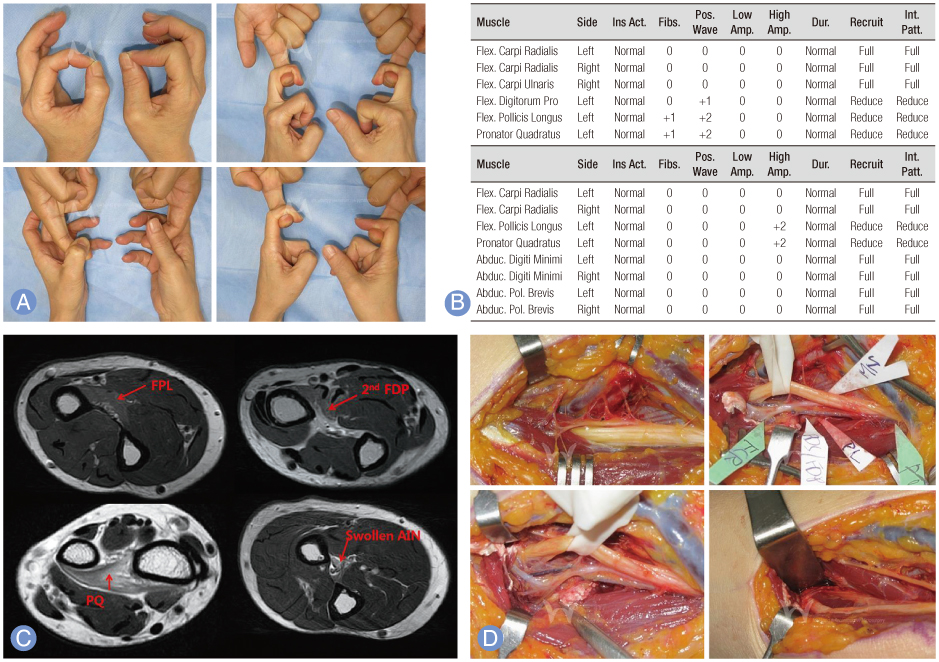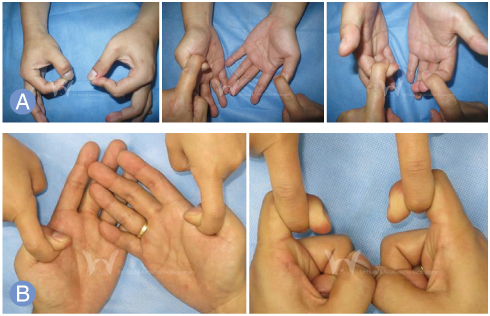J Korean Soc Surg Hand.
2017 Mar;22(1):49-56. 10.12790/jkssh.2017.22.1.49.
The Fate of Anterior Interosseous Nerve Syndrome
- Affiliations
-
- 1W Institute for Hand and Reconstructive Microsurgery, W Hospital, Daegu, Korea. handwoo@hotmail.com
- KMID: 2375467
- DOI: http://doi.org/10.12790/jkssh.2017.22.1.49
Abstract
- PURPOSE
We report the causes and prognosis of anterior interosseous nerve syndrome (AIN) according to the treatment.
METHODS
From March 2009 to December 2015, the 20 patients with the clinical symptom of AIN syndrome were enrolled in the study and electromyography (EMG) of AIN was performed. We retrospectively reviewed hand function test, active range of motion, the disabilities of the arm, shoulder and hand (DASH) score and EMG during the recovery from disease. We further surveyed the time of recovery and residual symptoms.
RESULTS
The patients with unknown cause of the disease (12 cases), heavy work or trauma (6 cases) and infection (2 cases) were investigated in the study. Thirteen out of 15 cases with conservative treatment and 2 out of 5 cases with a surgical treatment at an average of 8 months from disease were recovered. In addition, 8 cases with fine motor disturbance and 3 cases with tingling residual symptom were observed.
CONCLUSION
Due to the low possibility of entrapment neuropathy, conservative treatment for 7 months is the first choice rather than surgical treatment. If there is no improvement from the conservative treatment, surgical exploration of AIN is the indication of treatment. After recovery, patients may have the symptoms of fine motor disturbance and tingling.
MeSH Terms
Figure
Cited by 1 articles
-
Successful recovery of anterior interosseous nerve palsy caused by blunt trauma at the forearm level: a case report
Jae Woo Kim, Sung Hoon Koh, Jin Soo Kim, Dong Chul Lee, Kyung Jin Lee, Si Young Roh
Arch Hand Microsurg. 2024;29(4):281-286. doi: 10.12790/ahm.24.0040.
Reference
-
1. Tinel J. Nerve wounds: symptomatology of peripheral nerve lesions caused by war wounds. New York: William Wood;1918. p. 183–185.2. Parsonage MJ, Turner JW. Neuralgic amyotrophy; the shoulder-girdle syndrome. Lancet. 1948; 1:973–978.
Article3. Kiloh LG, Nevin S. Isolated neuritis of the anterior interosseous nerve. Br Med J. 1952; 1:850–851.
Article4. Lipscomb PR. Vascular and neural complications in supracondylar fractures of the humerus in children. J Bone Joint Surg Am. 1955; 37:487–492.
Article5. Fearn CB, Goodfellow JW. Anterior interosseous nerve palsy. J Bone Joint Surg Br. 1965; 47:91–93.
Article6. Nagano A. Spontaneous anterior interosseous nerve palsy. J Bone Joint Surg Br. 2003; 85:313–318.
Article7. Nigst H, Dick W. Syndromes of compression of the median nerve in the proximal forearm (pronator teres syndrome; anterior interosseous nerve syndrome). Arch Orthop Trauma Surg. 1979; 93:307–312.
Article8. Werner CO. The anterior interosseous nerve syndrome. Int Orthop. 1989; 13:193–197.9. Sood MK, Burke FD. Anterior interosseous nerve palsy: a review of 16 cases. J Hand Surg Br. 1997; 22:64–68.10. Dunne JW, Prentice DA, Stewart-Wynne EG. Bilateral anterior interosseous nerve syndromes associated with cytomegalovirus infection. Muscle Nerve. 1987; 10:446–448.
Article11. Wong L, Dellon AL. Brachial neuritis presenting as anterior interosseous nerve compression: implications for diagnosis and treatment: a case report. J Hand Surg Am. 1997; 22:536–539.12. Miller-Breslow A, Terrono A, Millender LH. Nonoperative treatment of anterior interosseous nerve paralysis. J Hand Surg Am. 1990; 15:493–496.
Article13. Seror P. Anterior interosseous nerve lesions: clinical and electrophysiological features. J Bone Joint Surg Br. 1996; 78:238–241.14. Spinner M. Injuries to the major branches of peripheral nerves of the forearm. 2nd ed. Philadelphia, PA: WB Saunders;1978. p. 162–192.15. Collins DN, Weber ER. Anterior interosseous nerve syndrome. South Med J. 1983; 76:1533–1537.
Article16. Futami T, Kobayashi A, Itoman M, Shilmajiri I, Fujita T. Clinical investigation on the anterior interossous nerve syndrome. J Jpn Soc Surg Hand. 1993; 10:338–341.17. Park MJ, Lee JY, Kim BJ. Anterior interosseous nerve syndrome: observations for three surgical cases. J Korean Soc Surg Hand. 1998; 3:301–308.18. Kim HM, Jeong C, Lee SU, Roh YT, Park IJ. The anterior interosseous nerve syndrome: clinical investigation of surgically treated 7 cases. J Korean Soc Microsurg. 2009; 18:67–74.19. Haussmann P. Intratruncal fascicular compression of the anterior interosseous nerve. Handchir Mikrochir Plast Chir. 1982; 14:183–185.20. Pan Y, Wang S, Zheng D, et al. Hourglass-like constrictions of peripheral nerve in the upper extremity: a clinical review and pathological study. Neurosurgery. 2014; 75:10–22.21. Aranyi Z, Csillik A, Devay K, et al. Ultrasonographic identification of nerve pathology in neuralgic amyotrophy: enlargement, constriction, fascicular entwinement, and torsion. Muscle Nerve. 2015; 52:503–511.
Article22. Hill NA, Howard FM, Huffer BR. The incomplete anterior interosseous nerve syndrome. J Hand Surg Am. 1985; 10:4–16.
Article23. Vichare NA. Spontaneous paralysis of the anterior interosseous nerve. J Bone Joint Surg Br. 1968; 50:806–808.
Article24. Maldonado AA, Amrami KK, Mauermann ML, Spinner RJ. Reinterpretation of electrodiagnostic studies and magnetic resonance imaging scans in patients with nontraumatic “isolated” anterior interosseous nerve palsy. Plast Reconstr Surg. 2016; 138:1033–1039.
Article25. Schantz K, Riegels-Nielsen P. The anterior interosseous nerve syndrome. J Hand Surg Br. 1992; 17:510–512.
Article
- Full Text Links
- Actions
-
Cited
- CITED
-
- Close
- Share
- Similar articles
-
- The Anterior Interosseous Nerve Syndrome
- Anterior Interosseous Nerve Syndrome following Bowling: A case report
- Bilateral Anterior Interosseous Nerve Syndrome: A Case Report
- Anterior Interosseous Nerve Syndrome with Varient Nerve Innervation: A Case Report
- Current Concepts of Anterior Interosseous Nerve Syndrome



